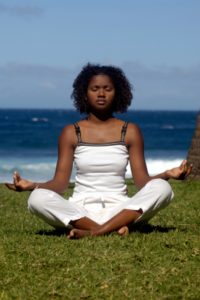Meditation…It’s more than just “ommm”
 Meditation – time spent in quiet thought – has been practiced for thousands of years and is one way to practice mindfulness. Most people think of meditation as a person sitting cross-legged, saying ‘ommm’. But there are actually many types of meditation. Even yoga or knitting can be used as forms of meditation.
Meditation – time spent in quiet thought – has been practiced for thousands of years and is one way to practice mindfulness. Most people think of meditation as a person sitting cross-legged, saying ‘ommm’. But there are actually many types of meditation. Even yoga or knitting can be used as forms of meditation.
The physical and mental benefits of meditation have been studied a lot in the past few years. Research has shown that meditation can…
- Improve the amount of time you are able to concentrate
- Decrease your anxiety
- Help you deal with stress
- Help you relax and stay calm
- Help slow your heart rate when you are stressed
Meditation can take as little as 1-5 minutes a day. It can be especially helpful when you feel that your mind is jumping from one thought to the next by allowing you to re-focus and center your thoughts. Times when you are alone such as first thing in the morning or after work/school may be the easiest times to include meditation in your day.
Try it out…
- Find a quiet and comfortable place to sit. If you are sitting in a chair make sure that your feet are firmly on the ground. Try to sit with good posture and allow your arms to relax down so your hands rest in your lap. You can keep your eyes open or closed.
- Set a timer for 3-5 minutes so you won’t be thinking about when to end the meditation.
- Focus on your breathing. You can concentrate on your belly going in and out as you breathe, the feeling of air rushing in and out of your nose, or repeat a word or phrase (mantra), such as ‘relax’ or ‘let go’, as you breathe. Try out different options to find one that works for you.
- If you start to think about something else, that is perfectly normal. Slowly and gently pull your attention back to your breathing and/or your word or phrase
- After 3-5 minutes have passed, slowly begin to move around and resume your normal day.
If you think it might be helpful to listen to meditation instructions, there are free iPhone and Android apps, such as “Stop, Breath & Think” and “Calm,” with a range of different meditation options. You can also check out meditation videos on YouTube and find free meditation guides in MP3 formats. Or you can check out your local community center or yoga studio to practice meditation with an instructor.
Remember that meditation takes practice and it may take time to become comfortable with meditating. With practice you may find that it becomes easier to regain your concentration when your mind starts wandering, even when you’re not meditating. It is also perfectly normal for your mind to wander or to feel distracted during meditation and it is possible to become so relaxed that you fall asleep.
Check out our guide on Meditation for more information.

